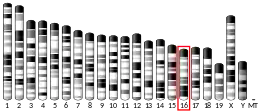OR2L13
Olfactory receptor 2L13 is a protein that in humans is encoded by the OR2L13 gene.[5]
| OR2L13 | |||||||||||||||||||||||||||||||||||||||||||||||||||
|---|---|---|---|---|---|---|---|---|---|---|---|---|---|---|---|---|---|---|---|---|---|---|---|---|---|---|---|---|---|---|---|---|---|---|---|---|---|---|---|---|---|---|---|---|---|---|---|---|---|---|---|
| Identifiers | |||||||||||||||||||||||||||||||||||||||||||||||||||
| Aliases | OR2L13, OR2L14, olfactory receptor family 2 subfamily L member 13 | ||||||||||||||||||||||||||||||||||||||||||||||||||
| External IDs | MGI: 3030000 HomoloGene: 88350 GeneCards: OR2L13 | ||||||||||||||||||||||||||||||||||||||||||||||||||
| |||||||||||||||||||||||||||||||||||||||||||||||||||
| |||||||||||||||||||||||||||||||||||||||||||||||||||
| |||||||||||||||||||||||||||||||||||||||||||||||||||
| |||||||||||||||||||||||||||||||||||||||||||||||||||
| |||||||||||||||||||||||||||||||||||||||||||||||||||
| Wikidata | |||||||||||||||||||||||||||||||||||||||||||||||||||
| |||||||||||||||||||||||||||||||||||||||||||||||||||
Function
Olfactory receptors interact with odorant molecules in the nose, to initiate a neuronal response that triggers the perception of a smell. The olfactory receptor proteins are members of a large family of G-protein-coupled receptors (GPCR) arising from single coding-exon genes. Olfactory receptors share a 7-transmembrane domain structure with many neurotransmitter and hormone receptors and are responsible for the recognition and G protein-mediated transduction of odorant signals. The olfactory receptor gene family is the largest in the genome. The nomenclature assigned to the olfactory receptor genes and proteins for this organism is independent of other organisms. [5] OR2L13 was recently implicated in regulating platelet reactivity and growth of abdominal aortic aneurysms [6]
See also
References
- GRCh38: Ensembl release 89: ENSG00000196071 - Ensembl, May 2017
- GRCm38: Ensembl release 89: ENSMUSG00000056822 - Ensembl, May 2017
- "Human PubMed Reference:". National Center for Biotechnology Information, U.S. National Library of Medicine.
- "Mouse PubMed Reference:". National Center for Biotechnology Information, U.S. National Library of Medicine.
- "Entrez Gene: OR2L13 olfactory receptor, family 2, subfamily L, member 13".
- Morrell CN, Mix D, Aggarwal A, Bhandari R, Godwin M, Owens P, et al. (May 2022). "Platelet olfactory receptor activation limits platelet reactivity and growth of aortic aneurysms". The Journal of Clinical Investigation. 132 (9). doi:10.1172/JCI152373. PMC 9057618. PMID 35324479.
External links
- OR2L13+protein,+human at the U.S. National Library of Medicine Medical Subject Headings (MeSH)
This article incorporates text from the United States National Library of Medicine, which is in the public domain.



